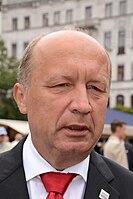Kubilius Cabinet II
 From Wikipedia the free encyclopedia
From Wikipedia the free encyclopedia
The Second Kubilius Cabinet was the 15th cabinet of Lithuania since 1990. It consisted of the Prime Minister and 13 government ministers (14 after the Ministry of Energy was re-established in 2009). The coalition consisted of the Homeland Union, National Resurrection Party (which suffered a split with both factions leaving the coalition by 2010), Liberal Movement, and the Liberal and Centre Union (which was later joined by a faction of the National Resurrection Party).
History
[edit]After the parliamentary elections in October, President Valdas Adamkus appointed Andrius Kubilius, the leader of the Homeland Union, as the Prime Minister on 28 November 2008. Kubilius had previously headed the 10th cabinet between 1999 and 2000. The 15th cabinet received its mandate and started its work on 9 December 2008, after the Seimas gave assent to its program.[6]
The coalition, which formed on 17 November 2008 and supported the government named itself the "Coalition of Change".[7]
In first two months of 2010 National Resurrection Party dissenters formed the new Christian Party. By this time, the government lost its majority and had to rely on support from the Lithuanian Peasants Popular Union, which lasted up until October of the same year, when the coalition once again got a majority.[1][8] In September 2011 the National Resurrection Party merged with the Liberal and Centre Union, which reduced the number of parties in the coalition from four to three. By April 2012 the government once again lost its majority in the Seimas.
Despite an economic crisis and the unpopular austerity measures that the government implemented to face it, the cabinet became the first government of Lithuania since independence to serve the full four-year term of the Tenth Seimas,[9] returning its mandate on 16 November 2012[10] after the elections to the Seimas in October. The government continued to serve in an acting capacity until the Butkevičius Cabinet started its work on 13 December 2012.[11]
Cabinet
[edit]The following ministers served on Kubilius Cabinet.[6]
References
[edit]- ^ a b "Valstiečiai pasirašys susitarimą dėl paramos A.Kubiliaus Vyriausybei". DELFI.
- ^ Freedom in the World 2011: The Annual Survey of Political Rights and Civil Liberties. Freedom House. November 2011. ISBN 9781442209947.
- ^ "Seimo valdyba". Seimas of the Republic of Lithuania. Retrieved 13 September 2017.
- ^ Frakcija viena lietuva ima spausti [dead link]
- ^ Mišrios Seimo narių grupės pareiškimas: valstiečiai liaudininkai Seime dirbs opozicijoje
- ^ a b "Ankstesnės Vyriausybės. Po 1990 metų". Government of the Republic of Lithuania.
- ^ www.DELFI.lt, Atnaujinta 12 30, Rasa Lukaitytė. "Pasirašyta Permainų koalicijos sutartis". DELFI.
{{cite web}}: CS1 maint: multiple names: authors list (link) CS1 maint: numeric names: authors list (link) - ^ House, Freedom (November 2011). Freedom in the World 2011: The Annual Survey of Political Rights and Civil Liberties. ISBN 9781442209947.
- ^ "Lithuania's final sprint". The Economist. 7 September 2012. Retrieved 13 May 2016.
- ^ "DĖL LIETUVOS RESPUBLIKOS VYRIAUSYBĖS GRĄŽINAMŲ ĮGALIOJIMŲ PRIĖMIMO IR PAVEDIMO JAI LAIKINAI EITI PAREIGAS". Seimas of the Republic of Lithuania. Retrieved 13 May 2016.
- ^ "Dėl lietuvos respublikos vyriausybės atsistatydinimo". Seimas of the Republic of Lithuania. Retrieved 13 May 2016.
- ^ "DĖL LIETUVOS RESPUBLIKOS KULTŪROS MINISTRO R. VILKAIČIO ATSISTATYDINIMO". Seimas of the Republic of Lithuania. Retrieved 13 May 2016.
- ^ "DĖL LIETUVOS RESPUBLIKOS ŪKIO MINISTRO D. KREIVIO ATSISTATYDINIMO". Seimas of the Republic of Lithuania. Retrieved 13 May 2016.
- ^ "Energetikos ministerija - Istorija". Government of the Republic of Lithuania. Retrieved 13 May 2016.
- ^ "DĖL LIETUVOS RESPUBLIKOS SVEIKATOS APSAUGOS MINISTRO A. ČAPLIKO ATSISTATYDINIMO". Seimas of the Republic of Lithuania. Retrieved 13 May 2016.
- ^ "DĖL LIETUVOS RESPUBLIKOS VIDAUS REIKALŲ MINISTRO R. PALAIČIO ATSISTATYDINIMO". Seimas of the Republic of Lithuania. Retrieved 13 May 2016.
- ^ "DĖL LIETUVOS RESPUBLIKOS VYRIAUSYBĖS GRĄŽINAMŲ ĮGALIOJIMŲ PRIĖMIMO IR PAVEDIMO JAI LAIKINAI EITI SAVO PAREIGAS". Seimas of the Republic of Lithuania. Retrieved 13 May 2016.
